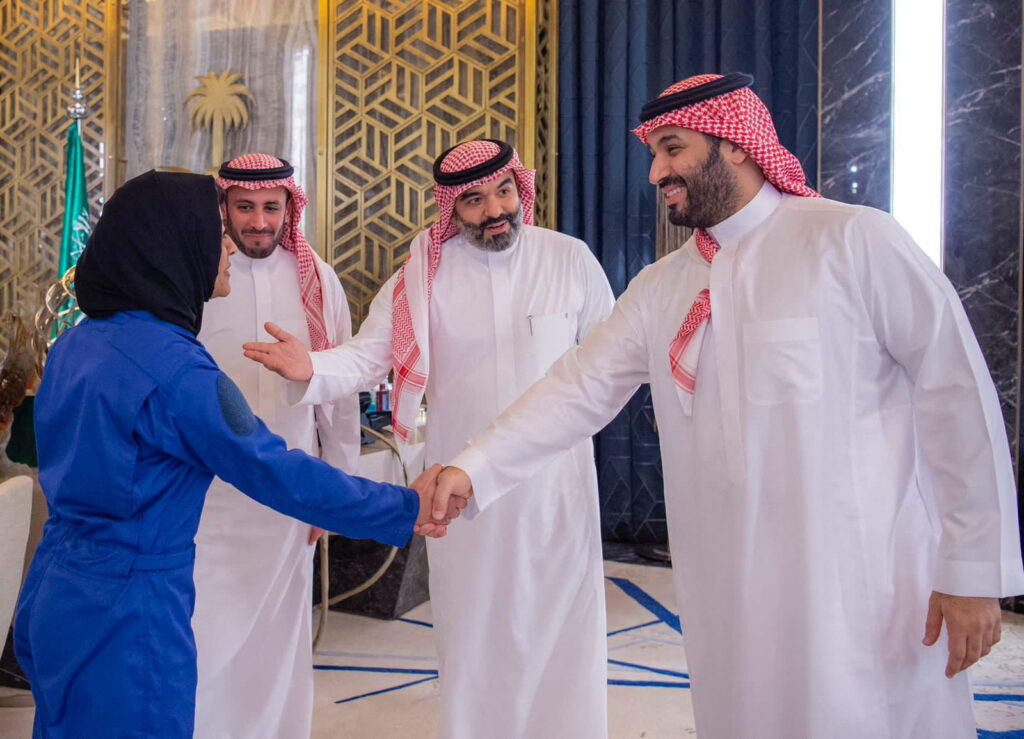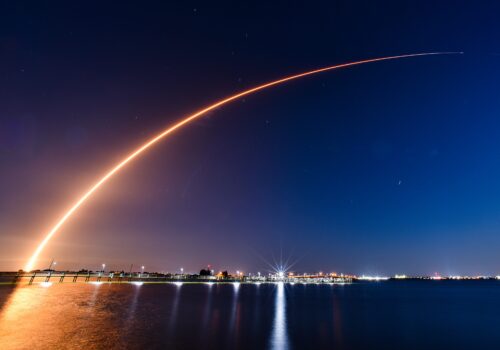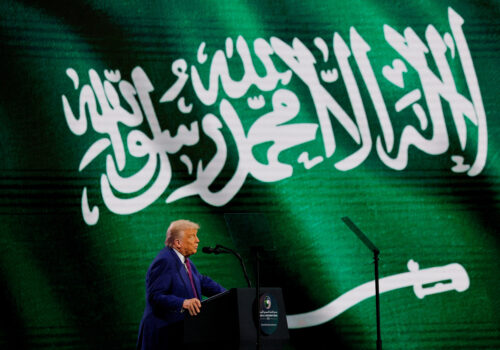What could NATO’s commercial space strategy mean for the Gulf?
In recent years, private-sector innovation has outpaced traditional state-run programs in launching satellites, developing space-based communications, and advancing Earth observation technologies. This shift has transformed commercial actors into essential players in modern space ecosystems.
Recognizing this, NATO unveiled its first Commercial Space Strategy (CSS) at the 2025 Summit in The Hague, calling for “a more systematic approach for identifying interoperability needs and developing standards in the military applications of commercial space solutions.” The five-page document outlines how NATO plans to serve as a central coordinator of commercial space capabilities by aligning investments, sharing data, and integrating private-sector technologies into allied operations.
The strategy is NATO’s most ambitious effort yet to harness the innovation and agility of the private sector to bolster collective security through protection of shared critical infrastructure, deterrence of hostile actions in space, and enhanced interoperability among allies and partners. It places commercial providers at the heart of future NATO missions, from satellite-based intelligence to resilient communications networks. This evolving framework echoes the model pioneered by the US Space Force, whose own 2024 commercial strategy and “Front Door” mechanisms have operationalized industry-government partnerships.
While designed for NATO’s thirty-two members, the strategy also opens the door to trusted non-NATO partners. Here, the Gulf emerges as a region with significant potential. Countries like the United Arab Emirates (UAE) and Saudi Arabia are investing heavily in dual-use technologies, while Bahrain, Kuwait, and Qatar already hold Major Non-NATO Ally (MNNA) status with the United States, offering a foundation for closer cooperation. This presents NATO with an opportunity, particularly in a region where strategic collaboration has long underpinned Western defense interests.

With strong US bilateral ties and ongoing collaboration between US Space Command and Gulf space firms, Washington is well-positioned to help extend NATO’s commercial space ecosystem to the region. Any such cooperation, however, must be governed by strict security protocols, ensuring reciprocity, transparency, and alignment with NATO standards, while limiting access to commercial services rather than full strategic integration.
Integrating commercial innovation into NATO defense
Under CSS, the alliance plans to align investments and share data among its thirty-two member nations, leveraging cutting-edge commercial technologies to support NATO missions. The strategy builds on steps established in 2019, when NATO first recognized space as an operational domain, and mirrors key elements of the US Space Force’s own approach.
For example, NATO will establish a “Space Front Door”–a hub linking space companies directly with NATO procurement and innovation teams. This single-entry portal is designed to facilitate the provision of services and solutions by commercial firms (ranging from satellite operators to launch providers) to NATO, and to keep them informed about alliance needs and standards. Officials hope it can evolve into a broader “NATO Front Door for Industry” across other tech domains. Another cornerstone is the creation of a Commercial Integration Cell at NATO, modeled on a similar US Space Force concept. This cell is designed to streamline how space companies work with NATO and member states, enabling real-time information sharing and operational coordination.
By adopting an allied version, NATO aims to accelerate secure collaboration with industry for missions like space surveillance, communications, and resilience. SPACENET is another key initiative. Under the NATO Industrial Advisory Group (NIAG), a dedicated platform, dubbed “NIAG-SPACENET,” was established in 2024 to solicit input from the commercial space sector. Through SPACENET, NATO engaged over three hundred space companies worldwide to identify technological and communication capability gaps, as well as potential commercial solutions. This direct industry outreach is already informing NATO’s plans, and it provides a ready mechanism to bring in vetted companies from beyond NATO, should the alliance seek broader partnerships. The strategy explicitly calls for mapping alliance requirements in main operational areas “to assess which areas could be enabled and enhanced by commercial contributions,” while avoiding overreliance on any single provider.
SIGN UP FOR THIS WEEK IN THE MIDEAST NEWSLETTER
In practice, this means NATO could turn to multiple private vendors for services like launch, satellite imagery, space-based Intelligence/Surveillance/Reconnaissance (ISR), or resilient satcom while also ensuring competition. Notably, the strategy encourages more flexible contracting methods and even floats the idea of a “civil space reserve” of pre-vetted commercial providers, ready to supply surge capacity in crises. These new tools and frameworks are designed to embed commercial space capabilities into NATO’s architecture quickly and efficiently. They could also offer a back door for trusted partners outside the alliance. As one NATO official explained, many dual-use space capabilities don’t neatly fall under traditional defense budgets, yet are “nonetheless critical in supporting defense-related services,” citing examples like space launch, logistics, and the protection of critical space infrastructure.
This creates an entry point for Gulf countries.
A strategic opening for Gulf space players
The Gulf region is undergoing a significant transformation in its space sector, with innovation and geopolitical positioning converging to offer NATO strategic opportunities for collaboration. As the alliance seeks to leverage commercial capabilities to enhance space resilience, Gulf space actors present an expanding pool of dual-use technologies, established partnerships, and growing space infrastructure. These assets could effectively serve NATO’s evolving requirements, particularly within the Global South and across critical energy and maritime corridors.
Over the past decade, Gulf countries, notably the UAE and Saudi Arabia, have achieved considerable progress. The UAE’s Mohammed Bin Rashid Space Centre (MBRSC) has cultivated partnerships with NASA, Japan Aerospace Exploration Agency (JAXA), and European Space Agency (ESA), successfully launched the “Hope” Mars mission in 2020, and is actively preparing for new lunar and asteroid missions. Abu Dhabi-based Bayanat, a component of the G42 group, is establishing itself as a regional leader in AI-powered remote sensing and ISR solutions. Its collaboration with US-based cybersecurity company, HySpecIQ, to develop hyperspectral imaging tools exemplifies the interoperability and technological complementarity emphasized by NATO’s CSS.
Saudi Arabia is similarly advancing its space agenda. Beyond its 2023 astronaut mission to the International Space Station (ISS) with Axiom Space, Riyadh has substantially expanded its domestic space program under Vision 2030, investing in satellite infrastructure, Earth observation, and nascent launch capabilities. Its accession to the US-led Artemis Accords in 2022 and the signing of an expanded cooperation agreement with NASA in 2024 signal a desire for deeper engagements with Western institutions.
Other Gulf states are also making notable contributions. Qatar’s Es’hailSat program secures sovereign communications infrastructure, while Bahrain’s collaboration with the UAE on the Light-1 CubeSat and Oman’s CubeSat launch attempt in 2022 represent significant milestones in building regional space capacity. These Gulf investments complement NATO’s CSS priorities: building resilience, expanding supplier diversity, and integrating advanced commercial technologies into defense operations.
Nevertheless, integration into NATO’s extended space ecosystem requires careful design. While the UAE and Saudi Arabia have expressed strong interest in aligning with Western-led frameworks, questions pertaining to political reliability, information-sharing norms, and dual-use governance persist within NATO circles. These challenges necessitate a phased, trust-building methodology.
A viable path forward could involve structured “partnerships of partners.” This model would enable vetted Gulf firms or agencies to engage indirectly through NATO member-led initiatives, multilateral exercises, or industry-specific interoperability forums. Such an approach would allow NATO to access Gulf capabilities while effectively managing sensitivities related to operational security and normative alignment.
The US as a bridge–and a stakeholder–in Gulf collaboration
The United States, as NATO’s leading space power and a longstanding partner to Gulf states, is uniquely positioned to facilitate this integration. In fact, Washington has been steadily cultivating space ties with the Gulf on a bilateral basis.
US commercial space companies should continue to engage in joint ventures and tech sharing in the Gulf, as well as USSPACECOM and Space Force initiatives to include Gulf allies in exercises. The US Space Force released its International Partnership Strategy on July 8, 2025, anchoring cooperation around three core lines of effort: “empower partners as force multipliers, enhance interoperability and information-sharing, and comprehensively align roles across force design, development, and employment.” While Gulf states are not mentioned by name, the document’s language leaves room for including emerging, like-minded Gulf actors to support those aims. Meanwhile, Gulf countries already host Space Force infrastructure, most notably the Space Campus at Al‑Udeid Air Base in Qatar, under Space Forces Central (USSPACEFOR‑CENT). This foothold establishes a natural foundation for deepening Gulf participation in regionally focused exercises and interoperability pilots.
Integrating Gulf actors under NATO’s space strategy, even informally, could amplify these US efforts and reduce the risk of Gulf states drifting toward China or Russia in space cooperation. For instance, NATO’s Space Front Door and industry portal could be opened to select non-member companies that meet security and reliability criteria.
Balancing ambition with caution
The opportunity before NATO and the Gulf is clear. By aligning their space ambitions, NATO gains a more resilient and innovative supply base and engages a region that is pivotal geopolitically. The Gulf states, in turn, gain integration into a premier security network. But this path must be navigated with foresight and discipline, and expanded partnerships should enhance strategic coherence, not complicate it. NATO must avoid the perception of creating a new bloc or stoking regional rivalries by focusing on collaboration on shared interests like space safety, disaster response, or anti-satellite threat monitoring. Gulf nations, for their part, will expect tangible benefits and respect for their autonomy as they step up cooperation. As NATO’s strategy observes, “challenges in one region can ripple across the alliance,” underscoring the interconnected nature of modern security. Nowhere is this more evident than in space, where a disruptive event, such as the jamming of satellites or orbital debris from an anti-satellite test, can have worldwide repercussions.
By drawing Gulf states into a closer orbit, NATO can help build a more sustainable and secure space environment to the benefit of all and US as the major NATO member and as an important Gulf ally is naturally posed to lead the way.
Manal Fatima is an assistant director at the Atlantic Council’s Scowcroft Middle East Security Initiative. She coordinates and facilitates the program’s activities while providing administrative support, particularly in overseeing the Iran Strategy Project and the broader initiative.
Further reading
Wed, Jul 16, 2025
What’s in NATO’s first-ever commercial space strategy?
New Atlanticist By Corey Jacobson
Released at The Hague summit, the Alliance’s new strategy is an important acknowledgement that the private sector is driving innovation in space.
Fri, Apr 25, 2025
Geopolitics in orbit: What Gulf moonshots mean for Washington
MENASource By
On a multipolar world stage with Russia and China power competition, it’s clear that space collaboration has all-too-earthly impacts.
Fri, May 23, 2025
The Gulf is emerging as Washington’s new strategic anchor
MENASource By Joze Pelayo
The so-called US “Golden Age for the Gulf” is one rooted in strategic utility, equal footing, high-stake deals, and fewer strings.
Image: Launch of a SpaceX Falcon 9 rocket on Starlink Mission 10-30. The rocket launched from Launch Complex 40 act Cape Canaveral Space Force Station at 3:57 a.m. Monday, August 4.



